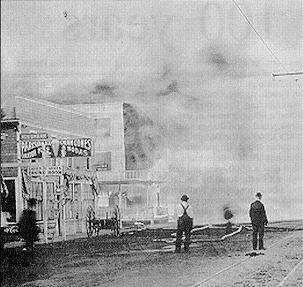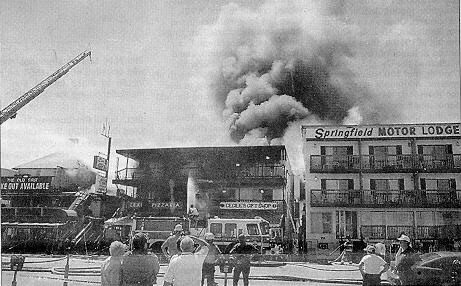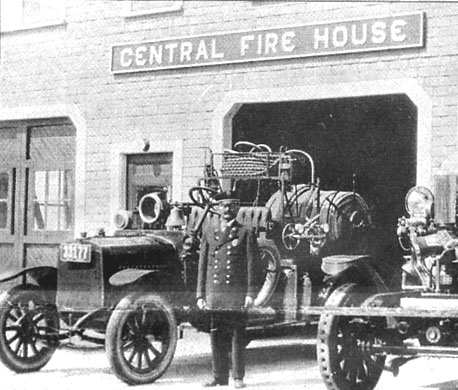September 28, 1999
Hampton's Great Blazes Scar Beach Area
By Steve Jusseaume, Staff Writer

The above photograph was taken where the Ashworth Hotel had burned.
[Courtesy photo/Emile Dumont]
The fire began in box of rubbish on B Street, and quickly spread throughout the closely built wooden structures, until finally 10 acres were leveled. Seven hotels, two theatres, 10 stores and as many as 40 cottages burned to the ground. A southerly wind blew the fire north across Ashworth Avenue and Nudd Avenue to Highland Avenue. Fire companies from Portsmouth, Amesbury. Salisbury and Exeter, joined Hampton firefighters during the battle.
"The loss is estimated at about $150,000. the assessor's valuation of the burned property totalling $108,000 and the personal property fully making up the balance." an article appearing in the Sept. 30, 1915 edition of what was then called The Hamptons Union stated.

the devastating fire that hit Hampton Beach in
1915.The blaze burned across 10 acres,
destroying seven hotels, two theatres, 10
stores and an estimated 40 cottages.
[Courtesy photo/Emile Dumont]
Six years later another fire jolted the beach. The June l921 blaze was called in at 3:34 a.m., and spread from the Strand to the Lawrence House and to the Janvrin. By 4 a.m., the blaze was out of control and fire crews from as far away as Haverhill were summoned to help fight it. At least 300 hotel rooms were destroyed, and the loss was estimated at $400.000.
As a result of the fire, the town assembled in special town meeting in July and adopted its first comprehensive building ordinance and appointed its first building inspector.
Fire also destroyed the Town Hall on Winnacunnet Road in March 1949. The March 24 issue of the newspaper reported that the fire completely gutted the 152-year-old structure at an estimated loss of $30.000." A northwest wind whipped the fire and firefighters had problems with the cold, the temperature being only 10 degree above zero on the morning of the blaze.
Town Hall buildings were rebuilt in the area and town business was carried on in essentially in the same location until just this year [1999]. In 1998 the town purchased the former Citizens Bank building one-quarter mile to the west, and is in the process of moving into the new building.

massive fire that struck Hampton Beach June 16, 1999.
[File photo/Tim Cook]
"Charred Shells" blared the headline in the June 18 issue of Hampton Union. Three neighboring buildings on Ocean Boulevard -- including the Old Salt, Springfield Motor Lodge and a storefront/apartment building known as the Beach Walk Enterprises -- were gutted in the massive, five-alarm fire." wrote reporter Michael Sharkey of the fire, the largest to hit the town in -- more than two decades.

Fire Chief Alexander H. Brown presided over the Hampton Beach Precinct Fire Station in 1922. The engine behind him was built by Brown and his son Percy from a used Kissell car. The engine to his left was new at the time. It was sold to collectors in the 1950s. [Courtesy photo]
Damage From 1915 Fire Adds Up
- George Ashworth, hotel — $10,000. cottage — $1,000
- Julius Benoit, cottage — $1,200
- C. H. Cutler, Lawrence House — $3,000
- Mrs. Belle Dearborn, cottage — $1,400
- J. S. DeLancey. 2 cottages — $1,000, hotel — $5,500
- Oscar Jenkins, cottage and cafe — $6,000
- Mrs. Dell A. Munsey, hotel — $11,000
- Mahoney store, wigwam — $7,500
- Mrs. Elmer F. Potts, cottage — $3,500
- Thomas Powers. hotel — $5,500
- L.C. Ring, Grand View — $8,00
- Store — $5,000
- Olympia Theatre — $2,000
- Ferncroft Gardens — $2,000
- Cottage — $1,500
- Katherine Hetherington, cottage — $1,800
- Edith L. Gilmore, cottage — $600
- Bertha Mills, cottage — $1,000
- E. L. Hovey, cottage — $5,000
- Charles Dodge, land and cottage, $2,800
- Edwin Janvrin, cottage — $2,800
- F. J. O’Dea, 2 cottages — $1,800
- J. H. Hamilton, cottage — $1,500
- C. D. Bickum, cottage — $1,600
- C. L. Higgins, cottage — $1,600
- John Cashman, cottage — $1,800
- Samuel Sussman, 2 cottages — $2,500
- W. P. Tucker, land and cottage — $1,300
- Louis Townsend land and cottage — $1,800
- James and Lucy Garland, house — $5,500
- Lydia J. Hunter, 2 cottages — $2,800
- E. M. Currier, cottage — $2,200
- A. M. Wells, cottage — $600
- J. Frank James, land and cottage — $2,200
- Episcopal church, not assessed
- Strand Theatre, not assessed
- Glendon cottage — $2,000
- Ring cottage, not assessed
